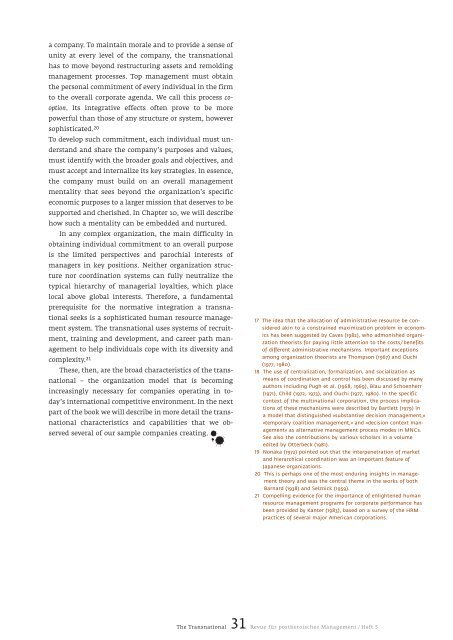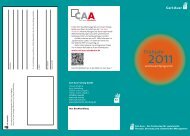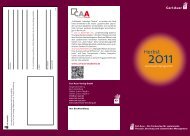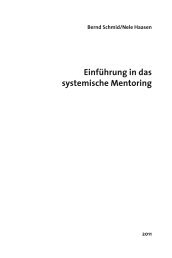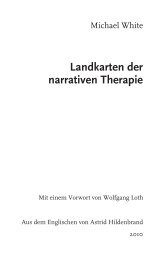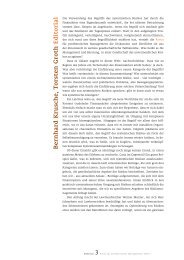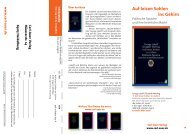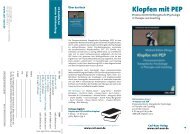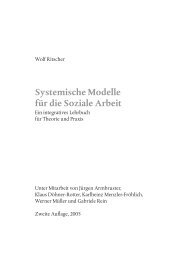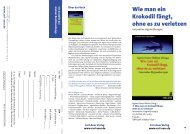K a trin G la tz e l E d ito ria l
K a trin G la tz e l E d ito ria l
K a trin G la tz e l E d ito ria l
Sie wollen auch ein ePaper? Erhöhen Sie die Reichweite Ihrer Titel.
YUMPU macht aus Druck-PDFs automatisch weboptimierte ePaper, die Google liebt.
a company. To maintain morale and to provide a sense of<br />
unity at every level of the company, the transnational<br />
has to move beyond restructuring assets and remolding<br />
management processes. Top management must obtain<br />
the personal commitment of every individual in the firm<br />
to the overall corporate agenda. We call this process cooption.<br />
Its integrative effects often prove to be more<br />
powerful than those of any structure or system, however<br />
sophisticated. 20<br />
To develop such commitment, each individual must understand<br />
and share the company’s purposes and values,<br />
must identify with the broader goals and objectives, and<br />
must accept and internalize its key strategies. In essence,<br />
the company must build on an overall management<br />
mentality that sees beyond the organization’s specific<br />
economic purposes to a <strong>la</strong>rger mission that deserves to be<br />
supported and cherished. In Chapter 10, we will describe<br />
how such a mentality can be embedded and nurtured.<br />
In any complex organization, the main difficulty in<br />
obtaining individual commitment to an overall purpose<br />
is the limited perspectives and parochial interests of<br />
managers in key positions. Neither organization structure<br />
nor coordination systems can fully neutralize the<br />
typical hierarchy of manage<strong>ria</strong>l loyalties, which p<strong>la</strong>ce<br />
local above global interests. Therefore, a fundamental<br />
prerequisite for the normative integration a transnational<br />
seeks is a sophisticated human resource management<br />
system. The transnational uses systems of recruitment,<br />
training and development, and career path management<br />
to help individuals cope with its diversity and<br />
complexity. 21<br />
These, then, are the broad characteristics of the trans-<br />
national – the organization model that is becoming<br />
increasingly necessary for companies operating in today’s<br />
international competitive environment. In the next<br />
part of the book we will describe in more detail the trans-<br />
national characteristics and capabilities that we observed<br />
several of our sample companies creating. ¶<br />
17 The idea that the allocation of administrative resource be considered<br />
akin to a constrained maximization problem in economics<br />
has been suggested by Caves (1982), who admonished organization<br />
theorists for paying little attention to the costs/benefits<br />
of different administrative mechanisms. Important exceptions<br />
among organization theorists are Thompson (1967) and Ouchi<br />
(1977, 1980).<br />
18 The use of centralization, formalization, and socialization as<br />
means of coordination and control has been discussed by many<br />
authors including Pugh et al. (1968, 1969), B<strong>la</strong>u and Schoenherr<br />
(1971), Child (1972, 1973), and Ouchi (1977, 1980). In the specific<br />
context of the multinational corporation, the process implications<br />
of these mechanisms were described by Bartlett (1979) in<br />
a model that distinguished »substantive decision management,«<br />
»temporary coalition management,« and »decision context management«<br />
as alternative management process modes in MNCs.<br />
See also the contributions by various scho<strong>la</strong>rs in a volume<br />
edited by Otterbeck (1981).<br />
19 Nonaka (1972) pointed out that the interpenetration of market<br />
and hierarchical coordination was an important feature of<br />
Japanese organizations.<br />
20 This is perhaps one of the most enduring insights in management<br />
theory and was the central theme in the works of both<br />
Barnard (1938) and Selznick (1959).<br />
21 Compelling evidence for the importance of enlightened human<br />
resource management programs for corporate performance has<br />
been provided by Kanter (1983), based on a survey of the HRM<br />
practices of several major American corporations.<br />
The Transnational 31 Revue für postheroisches Management / Heft 5


